|
This article was published in 3 parts in The Glyph, the journal of The Archaeological Institute of America, San Diego, Vol 1, No. 10 (Sept 1997); No. 11 (Dec 1977); No. 12 (March 1998).
Shroud photographs (not appearing in original article) are from Barrie M. Schwortz's Shroud of Turin Website (©Barrie M. Schworz, 1978) linked at the bottom of this page. This is one of the most comprehensive resources on the Shroud of Turin including scientific articles and extensive bibliographies.
The Shroud of Turin
Genuine artifact or manufactured relic?
Jack Kilmon
|
No single artifact of the past has so exemplified the interface between science and religion as the Shroud of Turin. What are the facts and how do we separate the facts from both religious and scientific bias and agenda-based conclusions? First, we must separate the shroud from that which is responsible for bias, namely that it is the burial shroud of Jesus of Nazareth and investigate it instead as a putative artifact of a first century crucifixion and burial. The shroud has been subjected to numerous scientific tests over the years culminating in 1988 with a radiocarbon measurement and dating procedure. The testing of the shroud and the conclusions reached lie basically in two areas, the physical shroud itself and the very unique image on the shroud.
Physical Examination of the Shroud
FACT: The shroud is a linen cloth measuring 4.6 x 1.1 meters corresponding to a standard measurement of 8 x 2 Philetaric cubits in use in Palestine during the first century. (see Whiston, W., Life and Works of Flavius Josephus, Winston. Chicago, p. 1008-1009)
FACT: The shroud is a herringbone twill with a 3:1 weave, of probably 1st century Syrian design. The flax fibrils contain entwisted cotton fibrils from a previous work of the loom. The cotton is Gossypium herbaceum, a Middle Eastern species not found in Europe. (Raes, G.: La Sindone, 1976; Tyrer, J. Textile Horizons, Dec, 1981)
FACT: The shroud contains pollen grains from 58 species of plants, 17 indigenous to Europe where the artifact has been for 7 centuries and the majority being plants indigenous, some exclusively, to the area of the Dead Sea and Turkey. These include Nyoscyamus aureus, Artemisia herba-alba and Onosma syriacum. (Frei, M., La Sindone, Scienza e Fide, Bologna, 1983; Frei, M., Shroud Spectrum International 3, 1982)
Conclusion: The linen of the shroud was manufactured and woven in the Middle East, most probably Syria, and is a design used in the 1st century, albeit uncommon and expensive.
Image on the Shroud
The shadowy image on the shroud is, of course, its most unique and enigmatic feature. It displays the complete dorsal and frontal image of a severely abused and crucified individual of Semitic characteristics who was laid on the proximal portion of the cloth with the distal portion folded over the head and extended over the body thus creating, through some as yet unexplained chemical or physical process, two "head to head" images of the back and front. The ghostly, sepia colored image is nearly imperceptable close-up but discernable at a distance. It was not until the first photographs were taken of the shroud in 1898 by Turin Councillor Secondo Pia that the negative plates revealed the startling "positive" of the clear picture of the "man in the shroud." The image is of a male, almost 6’ tall, bearded, severely abused and scourged with the distinctive "dumbell" markings of a Roman flagrum. Bloodstains are evident from wounds in the wrists, feet, about the head and brow, and the left thoracic area with pooling under the small of the back and under the feet. The image of the "man in the shroud" also displays signs of beating about the face, swelling under the eye and shocks of his beard having been ripped from his face (a common form of abuse to Jews by Romans). The debate on the authenticity of the shroud focuses on whether this image was transferred to the linen by some means from a real corpse or whether it was artificed by a clever forger.
Chief among the proponents of the image as a "painting" was W. C. McCrone, one of the most respected names in particle analysis. McCrone reliably detected iron-oxide particles throughout the shroud using only optical technique and attributed it to the base of artist’s paint. (McCrone, W. C., The Microscope, 29, 1981, p. 19-38; McCrone, W. C., Skirius, C., The Microscope, 28, 1980, pp 1-13.) Particular attention in this regard was given to the purported "bloodstains" of the image.
FACT: The shroud linen contains particles of iron-oxide.
The debate on the authenticity of the shroud became centered on whether the reliable presence of iron oxide was relevent to the shroud image and the "bloodstains" on the cloth and the precise nature and origin of the iron oxide. A part of the answer to this was provided by x-ray fluorescent analysis performed by STURP (Shroud of Turin Research Project) scientists R. A Morris, L. A. Schwalbe and J. R. London which determined there was no relevence between concentrations of iron oxide particles and the varying densities of the image. (Morris, R. A., Schwalbe, L. A., London, R. J., X-Ray Spectrometry, Vol 9, no. 2, 1980, pp 40-47; Schwalbe, L. A., Rogers, R. N., Analytica Chimica Acta 135, 1982, pp 3-19)
FACT: Iron Oxide is not responsible for the image on the cloth.
These findings stimulated additional attention to the bloodstains on the cloth. Were these genuine bloodstains or were they "painted" with some form of iron-oxide containing red pigment? This issue was addressed by experts in blood analysis, Dr. John Heller of the New England Institute and Dr. Alam Adler of Western Connecticut State University. Drs. Heller and Adler went far beyond the mere optical examination of McCrone. Applying pleochroism, birefringence and chemical analysis, they determined that, unlike artist’s pigment which contains iron oxide contaminated with manganese, nickel and cobalt, the iron oxide on the shroud was relatively pure. They discovered, through research into the procedures of flax preparation and linen manufacture, that pure iron oxide is normal to the process of fermenting (retting) the flax in large outdoor vats of water.
FACT: The iron oxide, abundant on the linen of the shroud is not the remnant of artist’s pigment.
Dr. Adler then proceeded to apply microspectrophotometric analysis of a "blood particle" from one of the fibrils of the shroud and unmistakeably identified hemoglobin in the acid methemoglobin form due to great age and denaturation. Further tests by Heller and Adler established, within scientific certainty, the presence of porphyrin, bilirubin, albumin and protein. In fact, when proteases were applied to the fibril containing the "blood," the blood dissolved from the fibril leaving an imageless fibril. (Heller, J. H., Adler, A. D., Applied Optics, 19, 1980, pp 2742-4; Heller, J. H., and Adler, A. D., Canadian Forensic Society Sci, Journal 14, 1981, pp 81-103)
FACT: The bloodstains on the cloth are not artist’s pigment but are real blood.
FACT: The bloodstains were applied to the cloth prior to the formation of the image.
Working independantly with a larger sample of blood containing fibrils, pathologist Pier Baima Bollone, using immunochemistry, confirms Heller and Adler’s findings and identifies the blood of the AB blood group. (Baima Bollone, P., La Sindone-Scienza e Fide 1981, 169-179; Baime Bollone, P., Jorio, M., Massaro, A. L., Sindon 23, 5, 1981; Baima Bollone, Jorio, M., Massaro, A. L., Sindon 24, 31, 1982, pp 5-9; Baima Bollone, P., Gaglio, A. Sindon 26, 33, 1984, pp 9-13; Baima Bollone, P., Massaro, A. L. Shroud Spectrum 6, 1983, pp 3-6.)
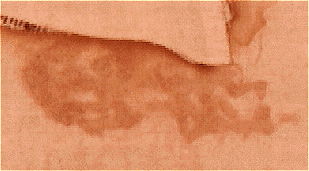
It is significant that analysis of the blood of the cloth demonstrated high levels of bilirubin consistent with the severe concussive beating suggested by the image of the "man of the shroud."
The 1988 Radiocarbon Dating of the Shroud
Radiocarbon dating is the use of accelerator mass spectrometry (AMS) to measure the amount of C14, a radioactive isotope of carbon. Plants take up carbon dioxide from the atmosphere as part of the process of photosynthesis and incorporate the carbon in the plant tissues. Animals absorb C14 into their tissues by eating plants. When the plant dies, no further C14 is absorbed and the C14 that accumulated in life begins to decay at a known rate. The half life of C14 is calculated at 5,730 years. Measurement of the C14 present in the remains of the plant or animal is a method of determining when the plant or animal died. The procedure is valuable for dating organic material later than 50,000 years before the present time. When first used, the procedure required larger samples of the test material, consequently the custodians of the Shroud of Turin were unwilling to permit the destruction of large portions of the shroud. The advances in the procedure has gradually decreased the amount of sample required and permission was finally obtained to test 12 small samples of the non-image bearing portion of the shroud linen. Linen is made from flax, therefore an assessment could be made on when the linen was manufactured. Samples of the shroud were excised and given to three different radiocarbon dating laboratories in Zurich, Oxford and Arizona. The results of the tests were published in the prestigious scientific journal Nature, 1988, titled "Radiocarbon Dating of the Shroud of Turin." The following results were published on the samples tested. The figures are uncalibrated "before present," i.e. 1950 CE. (P. E. Damon, etal., Radiocarbon Dating of the Shroud of Turin, Nature 337:6208, 16 February 1989, pp 611-615)
Sample dates from Arizona:
591 +/- 30 yrs
690 +/- 35 yrs
606 +/- 41 yrs
701 +/- 33 yrs
Sample dates from Oxford:
795 +/- 65 yrs
730 +/- 45 yrs
745 +/- 55 yrs
Sample dates from Zurich:
733 +/- 61 yrs
722 +/- 56 yrs
635 +/- 57 yrs
639 +/- 45 yrs
679 +/- 51 yrs
The linen of the shroud was manufactured, according to these results, sometime between 1260 CE and 1390 CE with the mean value placing the manufacture of the linen in the 14th century! The results were startling and fueled the opinion that the shroud is a forgery manufactured by a clever medieval artist. Are these results conclusive? A final conclusion on the authenticity of the shroud as an artifact of the first century should be based on a totality of the scientific evidence rather than on one procedure alone. That’s just good science, yet the results of this one procedure is totally oppositional to the many other procedures conducted and the use of radiocarbon dating of textiles has been shown to be problematic in the past. (ACS, Advances in Chemistry #205, Archaeological Chemistry III, American Chemical Society, 1984, Radiocarbon Dating by Particle Accelerator, an Archaeological Perspective). Having said this, let me make it clear that this article is not an indictment of AMS measurement which is an extremely valuable tool for archaeology. Like any new discipline, however, there are still many things to learn about extrinsic factors that may alter accurate measurement. The science of dendrochronology has been invaluable in "calibrating" AMS results. There is still much to learn about natural processes that may incorporate extrinsic carbon into testable substrates.
The "margin of error" claimed by radiocarbonists (within 95% confidence limits) is based strictly on hypothetical statistics. This is reflected in variable results by different testing laboratories on samples of known date. Some examples have been:
Organic materials involved in the Akrotiri volcanic eruption has produced results ranging from 1100 +/- 190 yrs to 2590 +/- 80 yrs, a difference of 1400 years.
The "Lindow Man" body from a peat bog in Cheshire dated conventionally to 300 BCE produced results of 5th century CE (Harwell) to the 1stcentury CE (Oxford).
Highlighting the problematic results of radiocarbon dating of textiles is the dating of mummy 1770 in the British Museum where the bones of the mummy dated 800 to 1,000 years earlier than the textile in which the mummy was originally wrapped.
Three areas of continuing research may explain how the radiocarbon dating of the shroud linen may have been affected by factors other than the true age of the artifact.
On December 4, 1532 The chapel at Chambery, France, where the shroud was housed, caught fire which raged around the silver reliquary where the shroud was kept. The heat was so intense that some of the silver melted and dripped onto the folded shroud. The shroud was rescued from the fire and doused with water but the burn holes are still visible.
FACT: The shroud was subjected to intense heat at low oxygen in 1532.
Dr. Dimitri Kouznetsov of the Sedov Biopolymer Research Laboratory in Moscow has conducted experiments on the accuracy of radiocarbon dating of samples previously exposed to intense heat. Dr. Kouznetsov acquired an ancient linen cloth with origin in Israel, radiocarbon dated to 200 CE. The cloth was exposed to intense heat in the presence of silver, after which it radiocarbon dated 1400 years later! Dr. Kouznetsov attributes this to biofractionalization and the chemical bonding, under heat, of extrinisic C14 to the linen. I will qualify that there are those who question Dr. Kouznetsov's scientific expertise and methodology.
Another source of extrinsic C14 incorporation in the linen of the shroud has been proposed by Researchers J. Mattingly and L. Garza-Vermes at the University of Texas in San Antonio, experts on the biogenic varnishes deposited on archaeological artifacts by bacteria and fungi. Upon examination of the shroud by Dr. Garza, heavy contamination was found. The radiocarbonists who tested the shroud samples also measured the C14 of the bacteria, fungi, and the bioplastic varnish deposited as a result of the symbiosis between the two organisms. The 1988 radiocarbon dating is the result of an averaging of the remaining C14 of the original linen with that of the microorganisms Lichenothelia and Rhodococcus and their resultant calcium carbonate varnish.
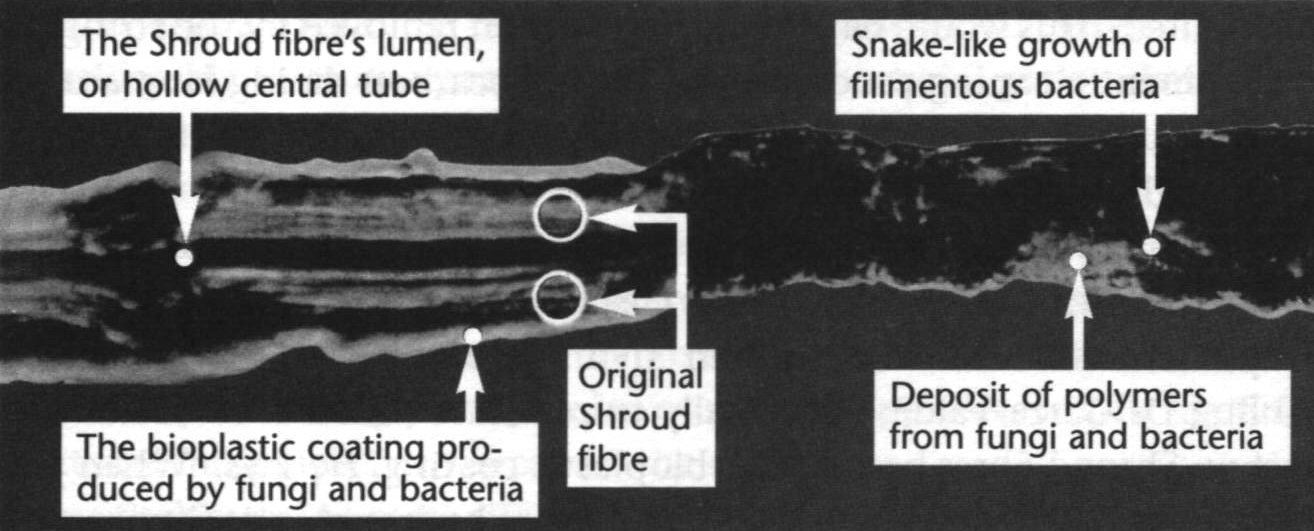 |
Microphotograph of microtomed shroud fibril by Dr. Garza-Valdez showing typical deposition of bioplastic coating and other fungal and bacterial accretion. From "The Blood and the Shroud" by Ian Wilson, 1998, The Free Press, NY, p225.
It is significant that the biopolymer coating can make up the most substantial portion of the fibril. The Texas team also duplicated the cleaning process used by all three radiocarbon labs, even increasing the strength of the solution. This process had absolutley no effect on the biopolymeric coating but instead dissolved some of the flax cellulose. This resulted in less C14 from the shroud itself and even more from the contaminating bioplastic varnish.
See Dr. Garcia-Valdes' Abstract to the Texas Medieval Association at:
http://users.aol.com/fcbrink/hsg/hsgart1.htm
FACT: The shroud of Turin is contaminated with the C14 containing bioplastic varnish of microorganisms still multiplying and present on the artifact.
FACT: The bioplastic varnish undoubtedly present on the shroud's fibrils, and incorporating significant amounts of younger and recent C14, is not effected by the cleaning procedure utilized by the three radiocarbon labs.
In addition to the heat of the 1532 fire and the established biocontamination of the shroud linen, one must also consider the possible effect of centuries of tallow candle smoke and incense.
Is there other evidence for the shroud being older than the radiocarbonists dating of the 14th century?
It is very suggestive that the face of the "man of the shroud" and its unique features has been depicted on iconography dating as early as the 6th century CE. Superimposition of the shroud face with the 6th century icon from St. Catherine’s monastery in the Sinai shows 170 points of congruity (Whanger, A. Applied Optics 24, no. 16, 1985, pp 766-772) as does the shroud face with the gold solidus of Justinian II (692 CE). Although this is very suggestive, one could pose that much of the iconography of the Byzantine period had some, now unknown, model and if the shroud was an artifice of 14th century Europe, an icon could have been used as a model. This would be a valid scientific counter-point. What would be required would be a depiction of what would be unmistakeably the shroud in a document or icon that pre-dates the 14th century date offered by the radiocarbon results. Such a representation would have to feature some unique characteristic of the shroud. Such a representation does indeed exist.
Sometime in the distant past, the folded shroud was subjected to abuse with a "hot poker," perhaps as an act of vandalism to a "Christian relic" or a "test of fire" by a zealous Christian. When folded, the four burn holes are arranged in an "L" shaped pattern. The unfolded shroud displays four sets of these four burn holes symetrically on both the dorsal and frontal halves of the shroud, evidence of the "hot poker" having penetrated the folded layers of the cloth. These burn holes are unique to the Shroud of Turin. In the Byzantine Christian era, the "gamma" and notched bands of Jewish talitoth were used as decorations on tunics and altar cloths. The Christians who adopted these patterns apparently were unaware that the band and the gamma were used on tunics of men (band) and women (gamma) respectively. See Yigael Yadin, Bar Kochba 1971, Random House, Chapter 7 "The Wardrobe" Pp 66-85. During the Byzantine period, around the 5th and 6th centuries, just at the time the "Image of Edessa" was rediscovered in the city wall, the "gamma" marking was used on altar cloths which were called "Gammadia." Did some overzealous Christian or vandal have this in mind when he burned the "gamma" shaped figure into the folded cloth?
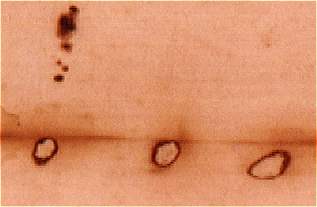
"Hot poker" holes in Shroud
An illustration of the entombed and enshrouded Jesus of Nazareth is found in a prayer book from Budapest known as the "Pray Manuscript." The illustration not only depicts the unique "L" pattern of burn holes but also the unique weave pattern of the shroud. There can be no mistake that the Pray Manuscript of 1192 was modeled from the Shroud of Turin. So much for the 14th century date claimed by the flawed radiocarbon dating and certainly support for Drs. Kouznetsov, Mattingly and Garza.
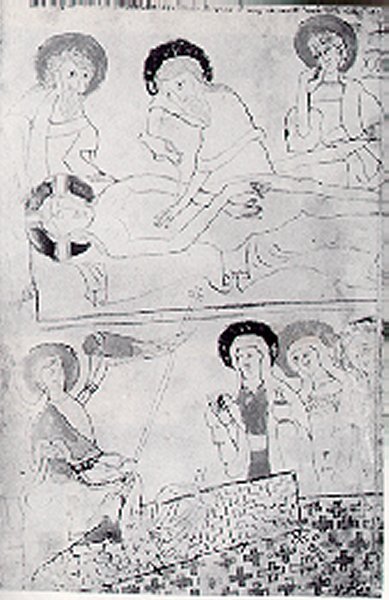
1192 Pray Manuscipt showing "hot poker" holes
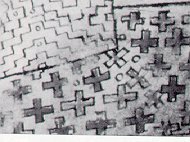
Close up of burn holes depicted on Pray manuscript matching exactly those on shroud.
Conclusion. The Pray Manuscript of 1192 illustrates what can only be the Shroud of Turin, predating the earliest possible date of manufacture calculated by the AMS testing.
All of what I have explained above can be found in the voluminous scientific and popular literature on the shroud of Turin. At this point, I would like to offer a different paradigm for assessing the accuracy of the 14th century date and the resulting claim that the shroud is the work of a 14th century forger. Again, this article is not addressing the issue of whether or not the Shroud of Turin was the burial cloth of Jesus of Nazareth and its value as a "relic" of Christianity. It addresses only whether the shroud is a genuine archaeological artifact of a 1st century crucifixion. This paradigm assumes that the radiocarbonists’ claim that the Shroud of Turin is a 14th century forgery is correct. It is based on what that conclusion tells us about the forger. It tells us that:
1. The forger first painted the bloodstains before he painted the image.
2. The forger integrated forensic qualities to his image that would only be known 20th century science.
3. The forger duplicated blood flow patterns in perfect forensic agreement to blood flow from the wrists at 65° from vertical to suggest the exact crucifixion position of the arms.
4. The forger "painted" the blood flows with genuine group AB blood that he had "spiked" with excessive amounts of bilirubin since the forger knew that severe concussive scourging with a Roman flagrum would cause erythrocyte hemolysis and jaundice.
5. The forger "plotted" the scourge marks on the body of the "man in the shroud" to be consistent under forensic examination with two scourgers of varying height.
6. The forger also duplicated abrasion and compression marks on the scourge wounds of the shoulders to suggest to 20th century forensic examiners that the "man in the shroud" had carried a heavy weight following the scourging.
7. The forger, against all convention of medieval artistry, painted the body he was "hoaxing" as Jesus of Nazareth, nude to conform to genuine Roman crucifixions.
8. The forger, as the forensic genius he was, illustrated the nails of crucifixion accurately through the wrists rather than the hands as in all other conventional medieval representations. He also took into account that the thumbs of a crucified victim would rotate inward as a result of median nerve damage as the nails passed through the spaces of Destot.
9. The forger was clever enough to "salt" the linen with the pollens of plants indigenous only to the environs of Jerusalem in anticipation of 20th century palynological analysis.
10. The forger was an artist who surpassed the talents of all known artists to the present day, being able to "paint" an anatomically and photographically perfect human image in a photographic negative manner, centuries before photography, and be able to do so without being able to check his work, close up, as he progressed.
11. The forger was able to paint this image with some unknown medium using an unknown technique, 30-40 feet away in order to discern the shadowy image as he continued.
12. The forger was clever enough to depict an adult with an unplaited pony-tail, sidelocks and a beard style consistent with a Jewish male of the 1st century.
13. The forger thought of such minute details as incorporating dirt from the bare feet of the "man in the shroud" consistent with the calcium carbonate soil of the environs of Jerusalem.
14. This forger was such an expert in 20th century biochemistry, medicine, forensic pathology and anatomy, botany, photography and 3-D computer analysis that he has foiled all the efforts of modern science. His unknown and historically unduplicated artistic technique surpasses all great historical artists, making the pale efforts of DaVinci, Michaelangelo, Raphael and Botticelli appear as infantile scribblings.
If the Shroud of Turin is a forgery of the 14th century, as the radiocarbonists claim, and not a genuine artifact of the 1st century, all of these qualities of the purported medieval "forger" must be accepted. If the Shroud was "forged" it would have to have been painted.
It is an irrefutable fact that there is NO paint or pigment on the Shroud of Turin leaving the only explanation of the technique of the forger to have used "photography" to manufacture the relic in the THIRTEENTH CENTURY!! Some authors have gone so far as to suggest exactly that. This is patently absurd!
CONCLUSION
The Shroud of Turin is a genuine artifact of a first century Roman crucifixion of an adult Jewish male. The radiocarbon dating placing the manufacture of the linen in the 14th century was flawed by extrinsic C14 accumulated over centuries of fungal growth, candle smoke and the intense heat of the fire of 1532. There is NO paint on the linen of the shroud and is not the artifice of a forger.
The Face of the Man of the Shroud
Bibliography
Anderson, A. W. Plants of the Bible, N.Y., 1957
Bercovits, I. Illuminated Manuscripts in Hungary, Dublin, 1969
Bowman, S. G. E., Ambers, J. C., Leese, M. N., Re-evaluation of British Museum
radiocarbon dates issued between 1980 and 1984. Radiocarbon 32, 1990, pp 59-
79.
Burleigh, R., Leese, M., Tite, M. An intercomparison of some AMS and small gas counter laboratories. Radiocarbon 28, 1986, pp 571-577
Dickenson, I., Preliminary details of new evidence for the authenticity of the shroud:
Measurement by the cubit. Shroud News 58, 1990
Gilbert, R., Gilbert, M. M. Ultraviolet-visible reflectance and fluorescence spectra of the Shroud of Turin. Applied Optics 19, 1980, 1930-1936.
Jumper, E. J., Ercoline, W. R., Three dimensional characteristics of the shroud image.
Proceedings of the IEEE International Congress on Cybernetics and Society, Seattle, 1982, pp 559-75
Miller, V. D., Pellicori, S. F., Ultraviolet fluorescence photography of the Shroud of Turin. Journal of Biological Photography 49, 1981, pp 71-75
Wilson, I., The Mysterious Shroud, Doubleday, NY, 1986
Wilson, I., The Blood and the Shroud, The Free Press, NY. 1998
For more information on the Shroud of Turin, go to: